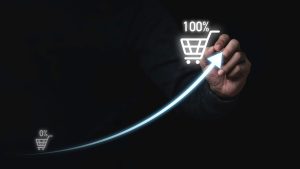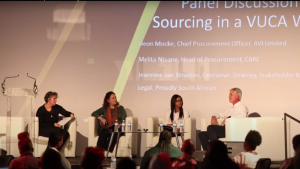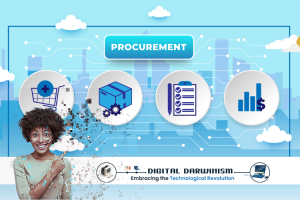A conversation with Walter Charles, Chief Procurement Officer, Biogen.
Walter Charles’ global procurement teams support billions of dollars in annual purchases. Having spent decades at Kraft Foods, Kellogg’s, Johnson & Johnson, and now Biogen, Charles provides keen insight into the state of procurement today as well as how big data analytics is disrupting the landscape to provide CPOs with meaningful answers to more strategic procurement execution.
Procurement trends in manufacturing
What are the major trends in manufacturing and how will these influence procurement organisations and proficiency?
I believe that disrupters are going to dominate the world. There are some trends that I talk about in an article in Supply Chain World, entitled The Next Productivity Gear. It covers how Biogen is rethinking how it approaches supplier discovery and how granularly we understand, clean-sheet and cost-model the items that we are buying. We point out that you need some sort of big data analytics engine to handle the mass avalanche of data at your disposal. This can help you to get to more meaningful answers quickly.
Imagine if you could include every single supplier possible in the bidding process to get an apples-to-apples comparison on critical criteria. What if you were able to find that ‘uber‘ performer in every single category and unlock the value proposition for your business to drive value for it? This is the power of big data analytics.
With big data analytics, you can evaluate 600 suppliers just as easily as you can evaluate 6. So, imagine sorting and getting to actual insights in seconds instead of months of pivot-table hell in MS Excel or with spreadsheets – which is the de-facto standard in the industry of analytics bids. I believe it is a game-changing framework.
The power of big-data analytics
What is big-data analytics and what can it do?
Big-data analytics helps your teams to not only find cool ideas that can actually drive differentiated value for your business, it also allows you to change benchmarks and standards. For example, last year we went through a benchmarking exercise with a bulge-bracket consultancy. They indicated that “while most sourcing organisations deliver in 6- to 7-times their costs, top core tile companies typically deliver about 10.4-times their costs”. Biogen is at 13.7. This means that we are delivering between 150% and 250% more savings with fewer people with bigger impact because of the tool constructs that we have bolted onto the back-end.
Has your technology investment been critical to Biogen’s success?
Absolutely. We’ve got technology that can crunch through data to get to actual insights in seconds. Even though you have technology, it is important to note that you must also fundamentally rethink the methodology that you are using in sourcing. I call this ‘constraint-less bidding’: if you don’t have the constraints of whatever it is limiting your ability to get after the entire population of players who compete, think about the possibilities.
Does big data require data scientists?
No. All you need is a very small population of people who understand how to leverage the tool to unpack the bids that you are after. I’ve done this at a scale of $10-billion at Kellogg’s and a scale of $12-billion at Kraft Foods. All I had was a small pool of six to ten people who were data-savvy. You will definitely need a category manager that can expand the aperture around what costs you’re looking at and the number of possible suppliers to get at the data the business can use to make more informed buying decisions.
Why aren’t more CPOs jumping on the big-data analytics train?
I think we’re at the tip of the spear. Typically, the one degree of freedom that you have in procurement at the large-enterprise level is changing the processes that you use to understand what you are buying and how to make that process the most robust it can be. But it takes time, knowledge and tools to be able to do that.
All of the major consulting firms say that there are 64 elements that you should be examining on every bid that you do at the stock-keeping unit (SKU) level, as it relates to direct materials. Imagine trying to find 64 different slices in MS Excel − you would never do that. With big data analytics you can take out individual slices and examine it, such as labour content, inputs associated with the bill of materials, the distribution of transportation, components that drive the cost for a particular item, etc. And, you could then ask key questions like, how can I be a more effective purchaser?
A real-world example of this was when I was at Kellogg’s. We were bidding a cocoa specification. Globally, there are 13 to 14 specifications for cocoa. In our granular examination, we found out that this particular cocoa specification comprised of 25% sugar. Because I had a huge sugar contract with Frosted Flakes, I knew exactly what I should be paying and I compared the two side-by-side. This discovery resulted in a considerable cost savings for the cocoa specification.
So, you’re saying that CPOs need to go wider and deeper to go after process improvements?
Correct. Imagine 100 times more suppliers and 100 times more granularity in your cost exploration − in the end, you wind up with something that is very robust. For example, Kraft has 5 100 SKUs that are just product labels. It takes about 900 different suppliers to give Kraft the 5.3-billion labels that they produce each year for their complete product line. Add to that the 100 cost elements per SKU and you’ve got about 450 million data elements that now need to be analysed.
Before big-data analytics, it used to take two and a half years to do a label analysis. Now, we process all 450 million data elements in just four months. We are able to unpack more costs, find more innovation and fix our obsolescence problems using this tool. For example, labels for products that did not sell would just sit on the shelf and we would have to throw them away. Using our technology tool, we are able to identify those products that had a shorter shelf life and move those to a digital, just-in-time label-printing construct.
Today, I am constantly going to my business with ideas on how we can change, pivot and, fundamentally, disrupt the current ecosystem to a differentiated set of outcomes. Our buy at Biogen is about $4-billion, which is pretty substantial. We have products in the pipeline that are designed to go after big neurological challenges, such as Alzheimer’s. I am excited to support these efforts by doing things smarter and better than we have been historically.
Adapted from JAGGAER


























